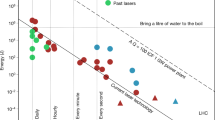Abstract
Tomography is used to reconstruct the inside cross section of an inaccesible object. To this end, a high number of cross section projections are required. In nuclear fusion devices, the plasma follows a toroidal shape and tomography can be used to estimate the two-dimensional spatial distribution of the plasma emission through a cross section. One of the objectives of tomography in plasma physics is to determine the number of localized emission peaks within the cross-section. Due to space restrictions in fusion devices, only a very limited number of projections can be experimentally measured and this introduces limitations to detect the number of emission peaks in the cross-section. This article describes a set of simulations to show that a multi-class classification system can be a valid alternative to tomography in plasma physics, even with the data of a single projection. Each class of the classifier represents the number of perturbations that can appear at any time in the plasma emissivity. To ensure the accuracy and reliability of the predictions, probabilistic classifiers (Venn predictors and Bayesian classifiers) have been used, with more reliable results from the Venn predictors. The probability intervals of Venn predictors with a single projection and intense/low respectively perturbations are [0.85, 0.93] and [0.62, 0.71] (to be compared with a probability 0.2 of a class random assignation). However, when the perturbation peaks are not strong enough and are lost into the emissivity background, the determination of the number of emission peaks can produce unreliable results. In these cases, to detect the plasma transition from an unperturbed state to a perturbed one (regardless of the number of perturbations) a martingale framework has been used. The changes have been detected by testing exchangeability with two different martingales: randomized power martingale and simple mixture martingale. Neither false alarms nor missed alarms have been observed with the former one and the average delay in the change recognition is between 16 and 72 samples (depending on cases). This means between 16 and 72 ms if the sampling period is 1 ms (it should be noted that the discharge length in ITER will be 50 min).
Similar content being viewed by others
References
Granetz, R.S., Smeulders, P.: X-ray tomography on JET. Nucl. Fusion 28(3), 457–476 (1988)
Navarro, A.P., Ochando, M.A., Weller, A.: Equilibrium-based iterative tomography technique for soft x-ray in stellarators. IEEE Trans. Plasma Sci. 19(4), 569–579 (1991)
Holland, A., Navratil, G.A.: Tomographic analysis of the evolution of plasma cross-sections. Rev. Sci. Instrum. 57(8), 1557–1566 (1986)
Navarro, A.P., Paré, V.K., Dunlap, J.L.: Two-dimensional spatial distribution of volumen emission from line integral data. Rev. Sci. Instrum. 52(11), 1634–1643 (1981)
Vega, J., Murari, A., González, S., Pereira, A., Pastor, I.: Spatial location of local perturbations in plasma emissivity derived from projections using conformal predictors. Nucl. Inst. Methods Phys. Res. A (2013). doi:10.1016/j.nima.2012.12.046
Shafer, G., Vovk, V.: A tutorial on conformal prediction. J. Mach. Learn. Res. 9, 371–421 (2008)
Vovk, V., Gammerman, A., Shafer, G.: Algorithmic Learning in a Random World. Springer, New York (2005)
Li, F., Wechsler, H.: Open set face recognition using transduction. IEEE Trans. Pattern Anal. Mach. Intell. 27(11), 1686–1697 (2005)
Gammerman, A., Nouretdinov, I., Burford, B., Chervonenkis, A., Vovk, V., Luo, Z.: Clinical mass spectrometry proteomic diagnosis by conformal predictors. Stat. Appl. Genet. Mol. Biol. 7(2), Article13 (2008)
Lambrou, A., Papadopoulos, H., Gammerman, A.: Reliable confidence measures for medical diagnosis with evolutionary algorithms. IEEE Trans. Inf. Technol. Biomed. 15(1), 93–99 (2001)
Balasubramanian, V.N., Gouripeddi, R., Panchanathan, S., Vermillion, J., Bhaskaran, A., Siegel, R.M.: Support vector machine based conformal predictors for risk of complications following a coronary Drug Eluting Stent procedure. Comput. Cardiol. 5–8 (2009)
Nouretdinov, I., Costafreda, S.G., Gammerman, A., Chervonenkis, A., Vovk, V., Vapnik, V., Fu, C.H.Y.: Machine learning classification with confidence: application of transductive conformal predictors to MRI-based diagnostic and prognostic markers in depression. NeuroImage 56(2), 809–813 (2011)
Vega, J., Murari, A., Pereira, A., González, S., Pastor, I.: Accurate and reliable image classification by using conformal predictors in the TJ-II Thomson Scattering. Rev. Sci. Instrum. 81(10E118), 4 (2010)
Makili, L., Vega, J., Dormido-Canto, S.: Incremental support vector machines for fast reliable image recognition. Fusion Eng. Des. 88, 1170–1173 (2013)
Papadopoulos, H.: Reliable probabilistic classification with neural networks. Neurocomputing 107, 59–68 (2013)
Lambrou, A., Papadopoulos, H., Nouretdinov, I., Gammerman, A.: Reliable probability estimates based on support vector machines for large multiclass datasets. In: AIAI 2012 Workshops, IFIP AICT 382, pp. 182–191. Springer (2012)
Nouretdinov, I., Devetyarov, D., Burford, B., Camuzeaux, S., Gentry-Maharaj, A., Tiss, A., et al.: Multiprobabilistic Venn predictors with logistic regression. In: AIAI 2012 Workshops, IFIP AICT 382, pp. 224–233. Springer (2012)
Duda, R.O., Hart, P.E., Stork, D.G.: Pattern Classification, 2nd edn. Wiley-Interscience (2001)
Martinez, W.L., Martinez, A.R.: Computational Statistics Handbook with MATLAB. Chapman & Hall/CRC, London (2002)
Doob, J.L.: Classical Potential Theory and Its Probabilistic Counterpart. Springer, Berlin (2001)
Ho, S.S., Wechsler, H.: A martingale framework for detecting changes in data streams by testing exchangeability. IEEE Trans. Pattern Anal. Mach. Intell. 32(12), 2113–2127 (2010)
Vovk, V., Nouretdinov, I., Gammerman, A.: Testing exchangeability on-line. In: Fawcett, T., Mishra, N. (eds.) Proceedings 20th International Conference Machine Learning, pp. 768–775. (2003)
Ho, S.S., Wechsler, H.: Detecting changes in unlabeled data streams using martingale. In: Veloso, M. (ed.)Proceedings 20th International Joint Conference Artificial Intelligence, pp. 1912–1917. (2007)
Fedorova, V., Gammerman, A., Nouretdinov, I., Vovk, V.: Plug-in martingales for testing exchangeability on-line. In: Proceedings of the 29th International Conference on Machine Learning. Edinburgh (2012)
Author information
Authors and Affiliations
Corresponding author
Rights and permissions
About this article
Cite this article
Vega, J., Murari, A., Dormido-Canto, S. et al. Simulations of nuclear fusion diagnostics based on projections with Venn predictors and context drift detection. Ann Math Artif Intell 74, 223–247 (2015). https://doi.org/10.1007/s10472-013-9393-3
Published:
Issue Date:
DOI: https://doi.org/10.1007/s10472-013-9393-3




